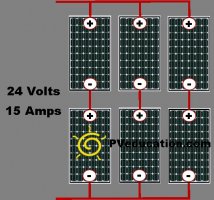Travis Watson
Member
- Joined
- Aug 6, 2017
- Messages
- 60
Apologies if this has been discussed, but I could only find relevant discussion for batteries.
But this is about solar panels!
I've seen that shading on a single solar panel can knock out the entire series string, and that's one of the benefits of parallel. However the higher voltage also has its benefits too.
So many combinethe two. But every time I've see them combined, it's series first, then parallel like so:

My question is -- why series-first? Wouldn't parallel-first give you more of that shade-resistance effect while giving the same high voltage output? What am I missing?
But this is about solar panels!
I've seen that shading on a single solar panel can knock out the entire series string, and that's one of the benefits of parallel. However the higher voltage also has its benefits too.
So many combinethe two. But every time I've see them combined, it's series first, then parallel like so:

My question is -- why series-first? Wouldn't parallel-first give you more of that shade-resistance effect while giving the same high voltage output? What am I missing?


